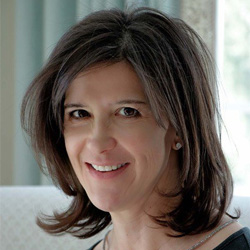The Work World: Becoming an Interior Designer
March is National Women’s History Month. What better time to launch the Work World Career Series?
Work World features Berkeley College Alumni who are achieving success in their professional careers, and are willing to share their knowledge about what it takes to make it in the industry.
In this first interview, we spoke with three members from the Board of Directors at the New Jersey chapter of American Society of Interior Designers (NJASID), including Holly George, President, Terri Fiori, Director At Large, and Sandy Cabelis, Membership Director. They had plenty to say about getting a good college education, building a career, the importance of networking, and how to maintain a well-balanced life.
 Although Holly thrived in her high school drafting class back in the day, her dreams of attending design school to become an architect were deferred, but never forgotten. After 20 years of working as a telecommunications software specialist, and an independent consultant for numerous companies like Sandoz – a division of Novartis Pharmaceuticals, ADT Security Services, and Lucent Technologies, Inc., she finally made her way back to the classroom to pursue her passion for a career in design. The Sussex County resident graduated from Berkeley College, Class of 2005, with an Associate’s degree in Interior Design.
Although Holly thrived in her high school drafting class back in the day, her dreams of attending design school to become an architect were deferred, but never forgotten. After 20 years of working as a telecommunications software specialist, and an independent consultant for numerous companies like Sandoz – a division of Novartis Pharmaceuticals, ADT Security Services, and Lucent Technologies, Inc., she finally made her way back to the classroom to pursue her passion for a career in design. The Sussex County resident graduated from Berkeley College, Class of 2005, with an Associate’s degree in Interior Design.
“Having a concept to help clarify the purpose of a design is probably one of the most valuable lessons that I learned at Berkeley,” said Holly. “Concept is a very strong guidepost to a design that is a cohesive, exciting result.”
 Before attending Berkeley College, Terri held a Bachelor’s degree in Communications – minoring in Art and Marketing. She worked in the product development industry for 10 years until her first child was born in 1996. When her son turned one year old, Terri started taking Interior Design courses at Berkeley College. She went to classes on the weekends and in the evening to graduate from the program in 2001.
Before attending Berkeley College, Terri held a Bachelor’s degree in Communications – minoring in Art and Marketing. She worked in the product development industry for 10 years until her first child was born in 1996. When her son turned one year old, Terri started taking Interior Design courses at Berkeley College. She went to classes on the weekends and in the evening to graduate from the program in 2001.
“As a part-time student it took me four years to graduate with my Associate’s degree, but by the time I graduated I had also given birth to my second child!” said Terri. “Most of the other students in the evening and weekends were also on their second career.”
 Sandy had a Bachelor’s degree and an M.B.A. before she came to Berkeley. She started at the Woodland Park campus and transitioned to Paramus, where she completed the program in March 2006. In addition to operating her interior design firm (like her two board colleagues) and raising a six-year-old son, she continues to stay active in the local community and is a member of the Parent-Teacher Association.
Sandy had a Bachelor’s degree and an M.B.A. before she came to Berkeley. She started at the Woodland Park campus and transitioned to Paramus, where she completed the program in March 2006. In addition to operating her interior design firm (like her two board colleagues) and raising a six-year-old son, she continues to stay active in the local community and is a member of the Parent-Teacher Association.
“Interior design is a very personality-based business, where you get to be you,” Sandy explained. “Know who you are as a person, as a designer, and as a creative professional. Seek clients who appreciate your value, and would be complementary to your personality and style of working.”
Why did you choose Berkeley College?
Holly George: I wanted to attend a two-year program so that I could begin working in the interior design industry right away.
Choosing an accredited program was also important to me because I was already familiar with the qualification requirements to take the National Council for Interior Design Qualification (NCIDQ) exam, to become a certified interior designer.
All of my professors at Berkeley were employed in the industry. That was meaningful to me as an adult student, because I understood the value in that. They were right on the edge of what was happening at the moment, teaching what they knew was important for students to understand.
Terri Fiori: A friend of mine had enrolled in the Interior Design program at Berkeley, which piqued my interest. Having a one-year-old at home during that time, made living close to the school an important factor. It was also important to me that the program was accredited.
Sandy Cabelis: I was searching for an accredited design school that would be convenient to attend while I was still working full-time during the day. Berkeley offered all of the courses that I needed to take during the evening hours, so that’s what worked for me. The curriculum included a diverse range of courses that covered the historical aspects of architect and design, artistic classes in color, sketching, and architectural construction. It was a well-rounded program.
The historical aspects of architecture and design are fundamental as you start getting into the field and specifying on projects. The ability to understand the roots and background of the different furniture and architectural details is essential.
Berkeley prepares you to work in different avenues, whether you want to work in residential or commercial design, which is good because you will need all of those skills.
How did you get started as an interior designer, and what do you enjoy most about your career?
HG: In my high school drafting class, I was assigned to design a vacation home. I remember getting so bogged down with the interior details, because I got so wrapped up in the mock-up planning and how I could make the rooms work, and how to make it look as cool on the inside as it did on the outside. I struggled to finish the project because I wanted to do so much more with the inside. That’s when I realized that the interior of a structure was more important to me than the outside of a structure. Planning is my favorite part of the design process – creating that initial flow and path. It’s like a giant puzzle to me.
I worked for designers Karla Trincanello and Jeffrey Brooks, before launching my firm. I decided to start my own business to have more control over my schedule so that I could spend time with my daughter, and scratch the itch to be an interior designer at the same time. I have 30 clients on my roster, but I’m actively working with three or four at the moment. I’m a one-person show, so I try not to take on too many projects at once.
My primary goal was not to build a large interior design firm. It was to do something that I love in my time frame.
TF: I started my career by word of mouth. Initially, I was a part-time designer as my three children were growing - my youngest is ten. I have a home-based interior design business based in Wyckoff, NJ. My work brings me to my clients’ homes, so for me, there is no reason to have a brick and mortar.
I offer an array of services from working with the architect and contractor in the initial stages of planning to space planning, furniture floor plans, procurement, and project management. We do a lot of custom design work, offering custom products.
Aside from being the principal designer, I have a project manager, a part-time design assistant, and a bookkeeper. We also hire freelancers. Typically we are working on 10 full room projects per year.
 My focus was initially on residential interior design, mainly in Bergen County. Now my work takes me outside of Bergen County with those clients to work on projects for their second homes.
My focus was initially on residential interior design, mainly in Bergen County. Now my work takes me outside of Bergen County with those clients to work on projects for their second homes.
I love that no day is ever the same. Every project presents a new “problem” to which we are hired for the solution.
SC: I was working in Manhattan, NY as a brand manager. Then one day I realized that it wasn’t my calling. Interior design was.
I landed my first job in interior design through a referral from my professor, and that was the beginning of my career. It would have taken a totally different path had it not been for her.
I began working as an interior designer for a few years at Safavieh – the company is now global. Through that experience, I was able to learn about all of the products, and I gained a strong understanding about the construction and quality of furniture. That is a really important piece of what you do as a professional when you work in residential design. I received many opportunities to take trips to the factories and see how furniture is made. That kind of retail-based job was extremely instrumental in my learning.
I worked for another interior design firm that was also retail-based. Then in 2010, I launched Cabelis Interior Design, LLC. I work out of my home in Montville, NJ, and currently, have about one dozen clients. I hire sub-contractors for research, drafting projects, and accounting when needed.
What I’m doing for a living is really the best I can do because it gives me a great work-life balance. I can work when my son is in school, sleeping in bed at night, or on the weekends when there’s someone else to watch him. One of the benefits of having your own firm is that you get to spend quality time with your family while pursuing a career.
What is the difference between working for a design firm and operating your own business? Any tips for those who want to open shop?
TF: I’ve been in business for more than 10 years. Like any business, it has its challenges. Being your own boss, it‘s on you to be consistent and to stick to a schedule. You are making at least 100 decisions every day. Don’t expect to be an overnight success. To gain experience and find your niche, work for someone else first. Don’t try to be like everyone else, because in a sea of interior designers, you need to stand out. Attend functions and network. Prepare and practice your pitch. Make sure you absolutely love this field.
SC: There are pros and cons to everything. When you work for an interior design company, that firm is responsible for marketing and bringing in clients, and your job is to design. People will come to see you, and you provide them with what they need. When you own a business you wear many hats, so you become responsible for everything including social media, accounting, and administrative duties. You’ll have to decide what type of brand you want to be in the industry. Then market and acquire your target customers, while keeping the business running smoothly. On the plus side, you get to be the creative director and determine what types of jobs you want to accept – whether it be commercial, residential, or something in between. You’ll need time for client communication, project specification, research, and shopping. The flexibility, time, and workload are all up to you. If you can’t do it yourself, hire someone part-time to help you. Figure out what works for you based on the size of your firm, and what your marketing budget will allow.
On the plus side, you get to be the creative director and determine what types of jobs you want to accept – whether it be commercial, residential, or something in between. You’ll need time for client communication, project specification, research, and shopping. The flexibility, time, and workload are all up to you. If you can’t do it yourself, hire someone part-time to help you. Figure out what works for you based on the size of your firm, and what your marketing budget will allow.
How did you become involved with the New Jersey chapter of ASID?
HG: When I was in school, my former professor Norris Cannon convinced me to revive a student chapter of ASID at Berkeley College in Paramus.
One of the main reasons that I recommend students get involved is for the relationship building and networking opportunities. ASID holds events that are specific to current students, recent graduates, and professional designers in need of advanced information and technology tools. Events are geared towards both ends of the spectrum. I have met so many skilled trade people and found so many resources for projects that aren’t available at the corner store.
TF: I became a student member while I was studying at Berkeley College. I love that ASID offers Continuing Education Units and events where you can sharpen your skills long after you graduate. There is so much that you need to know as an interior designer, and the field is constantly changing. The events were also a great place to meet with other designers. My journey to being appointed to the Board of Directors started with chairing the Marketing committee. I wanted to give back to the organization that provided me with education as well as publicity for my work.
SC: ASID was a nice way to bridge student life with what was going on in the interior design world. I appreciate how the professors at Berkeley encouraged us to branch out and beyond.
Being on the Board of Directors for the New Jersey chapter of ASID is an amazing experience and a privilege, because you’re speaking on behalf of the membership, and bringing them the tools that they need to be successful in the industry. I oversee Membership, Student Affairs, Emerging Professionals, and the Industry Partner Steering Committee.
Whether it be event programs, continuing education offerings, networking opportunities, trade shows, or trips, you’re really at the hub of that, trying to make positive changes for your organization. The program offers volunteer opportunities, student scholarships, Career Day, and a design contest. We invite people to check us out and become a member of our organization.
What advice do you have for students who want to study for a career in interior design?
HG: The difference between a person who can design and a designer, is that a designer is willing to do it for someone else. That’s an entirely different leap from having a knack for something because there’s a large degree of responsibility involved.
 Keep certification as a goal. If you’re going to spend the time to go to school to become an interior designer, be sure that the program that you are selecting has the approved number of required hours to make yourself eligible to take the NCIDQ exam in your state of residence.
Keep certification as a goal. If you’re going to spend the time to go to school to become an interior designer, be sure that the program that you are selecting has the approved number of required hours to make yourself eligible to take the NCIDQ exam in your state of residence.
No matter what particular area of design you’re working in, remember that the health, safety, and welfare of the people who use the space are the primary concern. You don’t learn that if you haven’t been educated. Some of it is specific information that you learn in class, some of it is information that you learn by working with other people, and some of it is plain old common sense. It really becomes a part of you. You can make a space look as beautiful as you would like, but the human value has to be at the source.
TF: Design is everywhere. If you are passionate about it you will excel. Read every publication or listen to podcasts on interior design. There are so many great ones out there.
I recommend that high school graduates work in several different areas of design (rug manufacturing, cabinetry, and more) to become an expert in each field so that when you go out on your own, you can take that knowledge with you. I would advise that students work for someone right out of school. That’s something I did not do, and I feel like my career would have taken off faster had I learned the ins and outs from a tenured professional.
SC: There is an opportunity for everyone. Interior design is a small industry, so stay connected. Stay after class and get to know your professors and fellow students, because you will see them again and again in your future. If you begin to build relationships with your professors, and they hear of an opening, they may think of you – because they know you and can speak about your work.
As you’re going through the program, you may gravitate towards residential or commercial design. Begin to look at companies that offer that type of work, and partner with people who are working in the field that interest you the most from a creative standpoint. That will help pull you along in your career.
How can students find a job after they graduate, or an internship opportunity while still in school?
HG: Internship opportunities are important. Not all schools require that you have one, but Berkeley did.
Through my friendship with Norris Cannon, who was one of my professors, I received an opportunity to intern for Jamie Drake, an internationally renowned interior designer. It was incredibly exciting, and so much fun! Jamie was an absolute gem. I first met him during my time as President of the Berkeley College Student Chapter of ASID. With the help of Norris, we arranged a chapter trip to visit Jamie at Gracie Mansion, where he discussed the renovation work that his firm did.
TF: Through your college. The ASID website has a listing of design jobs as well. Business of Home always lists internships. You can also find a job the old fashioned way, by sending your resume to design offices, and follow up with a phone call. If you can afford to work for free one or two days a week, find a designer whose work you love and offer to help out. Show your value while gaining experience so that when a job does open, you might be the first one they think of for the position.
SC: Today’s students have an advantage because they are developing a different skill-set. When I was attending school we had CAD, and social media did not exist. Students offer so much more to practicing design firms. We need your technology and social media skills. If you are currently looking for a job, be sure to promote those technology skills that you have, because that’s a real value. You are bringing something to the table, so there is a mutual and beneficial partnership that can be had.
When students are trying to land their first job, having a professional presence is incredibly important. Stay organized and keep track of what’s happening in the firm. Make sure that you see things through.
Attend industry events. Ultimately your end goal is to meet clients, but one of the most important things to do in the design business is to form relationships. These are people that you’re going to want to lean on later in your career.
What are your thoughts on the interior design industry overall?
HG: For the past four years or so, business seems to be ramping up again. I have noticed that general and sub-contractors are very busy. That’s a very good sign to me. That means people are starting to spend money on their homes and businesses again. People are starting to see the value in design and having a professional work with them.
TF: One of the biggest challenges in the industry is being able to stand out from the competition. There are so many designers in my area. Proving your value. Being shopped. We have been working on eliminating that last one as we offer mostly custom products.
Some firms are now charging by the project versus hourly. We started offering a hybrid method of charging last year, which has really worked out well for us.
SC: Interior design used to be fairly inaccessible to most people, and only the elite would have a designer. The HGTV boom really brought an awareness to the general public about the interior design industry, and what it is that we do. Although you cannot expect to get a room done in a day, as television sometimes depicts, lol!
Many people are starting to see the value of hiring an interior designer, and all types of people are reaching out for assistance on various types of projects big and small. There are so many different services you can provide to clients now. It’s just a matter of assessing the scope of the project and fees.
The Interior Design degree programs at Berkeley College (CIDA Accredited) focus on the creative and technical aspects of this exciting industry. Graduates are prepared with the necessary skills and practical knowledge to enter the industry in a range of roles.
To learn more about Interior Design degree programs and other majors, visit Berkeley College.
The views and/or opinions in this article are those of the individuals interviewed. The academic achievements and/or employment outcomes described in this article are specific to each individual and are not a guarantee of similar results for past or current students. For up-to-date and detailed information, please visit BerkeleyCollege.edu and view our catalogs at BerkeleyCollege.edu/publications.

